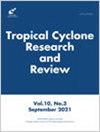2013-2023年北印度洋热带气旋风眼分析
IF 4.1
4区 地球科学
Q3 METEOROLOGY & ATMOSPHERIC SCIENCES
引用次数: 0
摘要
本文研究了2013 - 2023年北印度洋(NIO)热带气旋眼。tc的特点是一个温暖无云的区域,称为眼。近年来,气象学家对热带气旋风眼的几何和热力学特性产生了浓厚的兴趣,因为这些特性对热带气旋的业务预报非常有用。在这项研究中,我们分析了来自INSAT-3D/R卫星的数据、被动微波图像和热力学参数,历时11年(2013-2023年)。分析表明,37.73%的tc在NIO上空形成了眼,其中60%发生在阿拉伯海(AS), 40%发生在孟加拉湾(BoB)。风眼最常在风暴开始后36小时(1.5天)被观测到(34节)。形成风眼的平均最大持续风速为66节,在NIO上空的标准差为14.26节。平均估计眼中心压为982.15 hPa。在BoB平均纬度为13.60°N,经度为83.67°E,标准差分别为2.33°和5.93°。流星雨眼的平均半径为22.3公里(直径为44.6公里)。计算的眼圆度值(ERV)为0.59,范围为0.5 ~ 0.8。TC眼在NIO上空的平均强度为Dvorak T4.0(64-89节)。在TC眼形成之前观察到的主要模式是弯曲带模式。我们的研究结果表明,当一个人向极地移动时,眼睛的大小和数量都会增加。本研究结果对业务预报员和灾害管理者在减轻社会经济影响和保护人类生命方面具有重要价值。本文章由计算机程序翻译,如有差异,请以英文原文为准。
Analysis of tropical cyclone eye over the North Indian Ocean during 2013–2023
This study examines the tropical cyclone (TC) eyes over the North Indian Ocean (NIO) from 2013 to 2023. TCs feature a warm and cloud-free region called the eye. In recent years, meteorologists have taken a keen interest in geometric and thermodynamic characteristics of TC’s eye as these attributes are useful for operational forecasting of TCs. In this study, we analyzed data from the INSAT-3D/R satellite, passive microwave imagery, and thermodynamic parameters over an 11-year period (2013–2023).
Analysis showed that 37.73 % of the TCs developed an eye over the NIO, with 60 % of these occurring in the Arabian Sea (AS) and 40 % in the Bay of Bengal (BoB). The eye was observed most frequently approximately 36 h (1.5 days) after the storm's onset (>34 knots). The mean maximum sustained wind speed at which an eye formed was 66 knots, with a standard deviation of 14.26 over the NIO. The average estimated central pressure of the eye was 982.15 hPa. TCs' eyes formed at an average latitude of 13.60°N and longitude of 83.67°E in the BoB, with standard deviations of 2.33° and 5.93°, respectively. The average radius of a TC's eye was 22.3 km (with a diameter of 44.6 km) over the NIO. The calculated Eye Roundness Value (ERV) was 0.59, with a range from 0.5 to 0.8. The average intensity of TC's eyes over the NIO was classified as Dvorak’s T4.0 (64–89 knots). The dominant pattern observed before the formation of the TC's eye was the Curved Band Pattern. Our results indicated that as one moves poleward, both the size and number of eyes increase.
The findings of this study are valuable for operational forecasters and disaster managers in mitigating socioeconomic impacts and preserving human lives.
求助全文
通过发布文献求助,成功后即可免费获取论文全文。
去求助
来源期刊

Tropical Cyclone Research and Review
METEOROLOGY & ATMOSPHERIC SCIENCES-
CiteScore
4.60
自引率
3.40%
发文量
184
审稿时长
30 weeks
期刊介绍:
Tropical Cyclone Research and Review is an international journal focusing on tropical cyclone monitoring, forecasting, and research as well as associated hydrological effects and disaster risk reduction. This journal is edited and published by the ESCAP/WMO Typhoon Committee (TC) and the Shanghai Typhoon Institute of the China Meteorology Administration (STI/CMA). Contributions from all tropical cyclone basins are welcome.
Scope of the journal includes:
• Reviews of tropical cyclones exhibiting unusual characteristics or behavior or resulting in disastrous impacts on Typhoon Committee Members and other regional WMO bodies
• Advances in applied and basic tropical cyclone research or technology to improve tropical cyclone forecasts and warnings
• Basic theoretical studies of tropical cyclones
• Event reports, compelling images, and topic review reports of tropical cyclones
• Impacts, risk assessments, and risk management techniques related to tropical cyclones
 求助内容:
求助内容: 应助结果提醒方式:
应助结果提醒方式:


